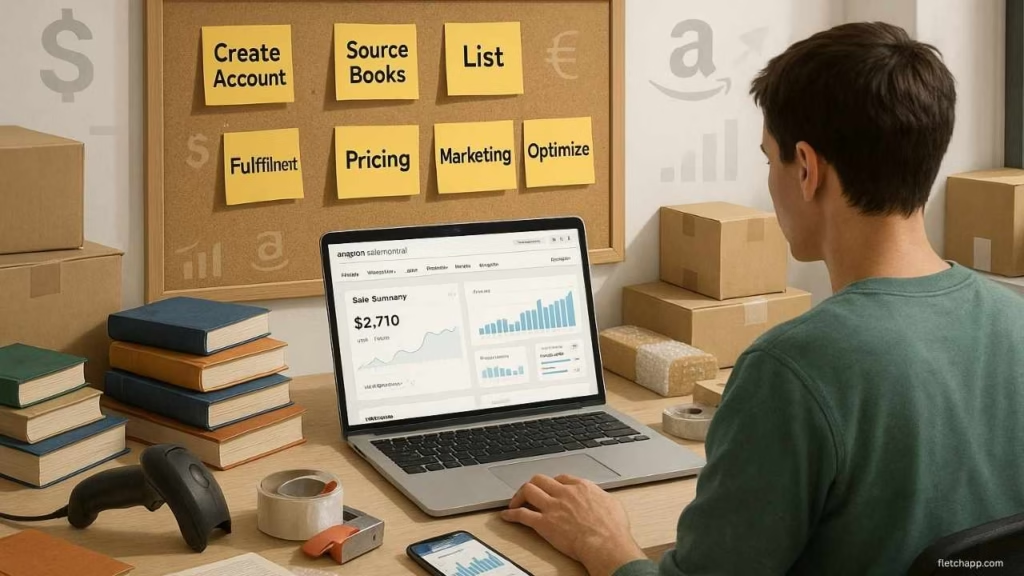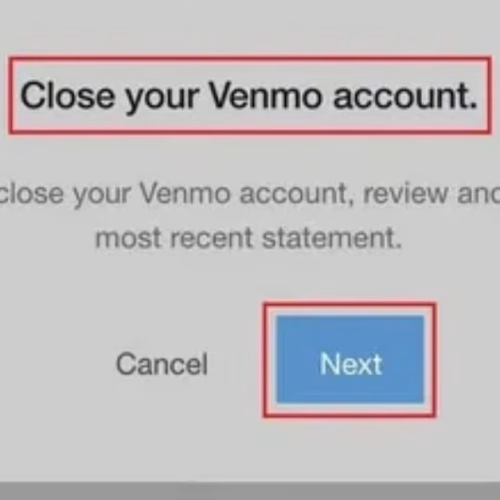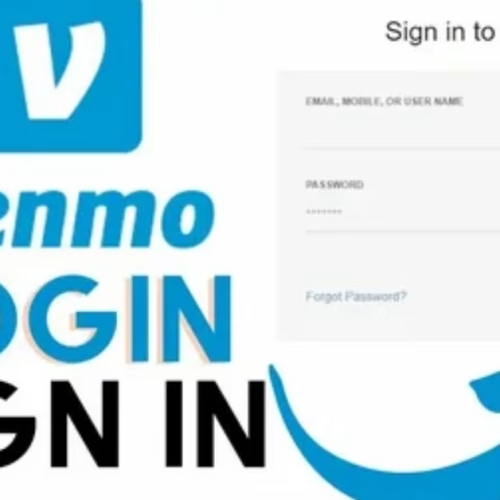Introduction
Selling books on Amazon is a fantastic opportunity to turn your old textbooks, novels, or collectibles into extra cash, particularly for students and educators seeking a flexible side hustle. With Amazon’s massive customer base of over 300 million active users, you can reach buyers worldwide while managing your sales with user-friendly tools. Whether you’re wondering how to sell books on Amazon, how to sell things on Amazon, or even how to sell used books on Amazon.
This blog provides a clear, step-by-step path to help you start, avoid common mistakes, and maximize your profits. Plus, it aligns with privacy-focused platforms like Fletch App, which prioritize secure data handling. Let’s explore seven practical steps to help you master how to start selling on Amazon and turn your books into a profitable venture in 2025.
Why Sell Books on Amazon?
Amazon is the world’s largest online marketplace, making it a prime platform for selling new, used, or rare books. Here’s why it’s an excellent choice for anyone looking to learn how to sell items on Amazon or how to sell stuff on Amazon:
- Low Startup Costs: You can begin with books you already own, like old textbooks or novels, keeping your initial investment minimal.
- Huge Audience: Connect with millions of buyers searching for everything from fiction to academic texts, ensuring high visibility for your listings.
- Flexible Options: Choose between self-fulfillment (Fulfillment by Merchant, or FBM) or Amazon’s Fulfillment by Amazon (FBA) for convenience, depending on your needs.
- Privacy Focus: Amazon’s secure platform protects your data, a value shared by Fletch App, which emphasizes user privacy in its educational tools.
Additionally, Amazon offers opportunities to explore how to sell products on Amazon beyond books, such as electronics or collectibles, and even how to sell on Amazon without inventory through methods like Kindle Direct Publishing (KDP) for ebooks. This flexibility makes it a versatile platform for beginners and experienced sellers alike.

Step 1: Create an Amazon Seller Account
To begin your journey of how to sell books on Amazon, you need an Amazon Seller Central account. Here’s how to set it up:
- Visit sell.amazon.com and click “Sign up.”
- Choose a selling plan based on your goals:
- Individual Plan: Pay $0.99 per sale, perfect for those selling fewer than 40 books monthly. This is ideal for students testing how to sell something on Amazon.
- Professional Plan: Pay $39.99/month for advanced tools like analytics and advertising, suited for high-volume sellers.
- Provide your business details, including a business name, address, and payment information.
- Verify your identity with a government-issued ID and bank account details. This process typically takes 5–8 days.
- Set up your seller profile with a professional business name and contact details for transparency.
Pro Tip: If you’re a student or educator exploring how to sell items on Amazon, start with the Individual Plan to avoid monthly fees while you learn the ropes. If you have questions about your account, you can learn how to contact seller on Amazon through Seller Central’s Help section or Amazon’s support team.
Step 2: Source Profitable Books
Finding the right books is the foundation of success when learning how to sell books on Amazon. Here are proven strategies to source books that sell:
- Your Bookshelf: Begin with books you already own, such as outdated textbooks, novels, or collectibles. This is a low-risk way to start how to sell used books on Amazon.
- Thrift Stores and Library Sales: Visit local thrift shops, used bookstores, or library sales to find high-demand books at low prices. Look for textbooks, rare editions, or popular genres like sci-fi.
- Online Arbitrage: Purchase discounted books on platforms like eBay, Facebook Marketplace, or Book Outlet to resell on Amazon. This is a smart approach for how to sell stuff on Amazon profitably.
- Wholesalers: Buy books in bulk from distributors like Book Depot or Ingram Content Group for higher margins, especially for new or popular titles.
- Check Demand: Use the Amazon Seller App to scan a book’s International Standard Book Number (ISBN) and check its Best Seller Rank (BSR). Aim for books with a BSR under 100,000, as they sell faster.
Example: A student in Springfield, MO, found a used textbook with a BSR of 50,000 at a thrift store for $2 and sold it for $20 on Amazon, earning a $15 profit after fees. By focusing on high-demand categories, you can master how to sell products on Amazon effectively.
Pro Tip: Always verify the condition of used books to ensure they meet Amazon’s standards (e.g., no water damage, intact pages) to avoid returns and maintain buyer trust.
Step 3: List Your Books
Creating accurate and appealing listings is key to standing out on Amazon. Here’s how to list your books effectively when mastering how to sell books on Amazon:
- Find the Book: In Seller Central, search for your book using its ISBN or title, or scan it with the Amazon Seller App for quick matching.
- Select Condition: Choose the appropriate condition—New, Used – Like New, Used – Very Good, Used – Good, or Used – Acceptable—following Amazon’s guidelines. For example, “Very Good” means minor wear but no missing pages or heavy markings.
- Write a Description: Provide a clear, honest description of the book’s condition, noting any highlights, creases, or wear for used books. This builds trust and reduces returns.
- Set a Price: Check prices for similar listings in the same condition. Slightly undercutting competitors can help you win the Buy Box, Amazon’s algorithm-driven “Add to Cart” button that drives most sales.
- Choose Fulfillment: Decide between FBM or FBA (detailed in Step 4).
Example: For a used textbook, you might write: “Used – Very Good: Clean pages, minor cover wear, no highlights.” This clarity helps buyers feel confident, a key factor in how to sell used books on Amazon.
Pro Tip: Double-check the ISBN to avoid listing restricted editions, such as teacher’s manuals or international versions, which Amazon may prohibit. If you’re unsure, contact Amazon support to clarify how to contact seller on Amazon for guidance.
Step 4: Choose a Fulfillment Method
Deciding how to handle shipping and customer service is a critical step in how to sell things on Amazon. You have two main options:
- Fulfillment by Merchant (FBM): You store, pack, and ship books yourself. This is ideal for small-scale sellers or those with low-cost books, as it avoids Amazon’s storage fees. However, you handle customer service and returns.
- Fulfillment by Amazon (FBA): Send your books to Amazon’s warehouses, and they handle storage, packing, shipping, and customer service. FBA books are Prime-eligible, increasing visibility, but you pay storage and fulfillment fees (e.g., $3–$5 per book, depending on size).
- Packaging Tips: For FBM, use bubble wrap or cardboard to protect books during shipping. If sending multiple books, wrap each individually to prevent damage. For FBA, follow Amazon’s prep guidelines, such as labeling and poly-bagging.
Note: FBA is a time-saver for busy students or educators, as Amazon handles logistics, but use the Amazon Revenue Calculator to check if fees leave enough profit. For example, a $20 book might yield $12 after FBA fees, compared to $15 with FBM.
Alternative Option: If you’re curious about how to sell on Amazon without inventory, consider Kindle Direct Publishing (KDP). You can self-publish ebooks or print-on-demand paperbacks, and Amazon handles production and shipping. This is perfect for aspiring authors or those wanting to avoid physical inventory.
Pro Tip: Start with FBM to learn how to sell something on Amazon without upfront costs, then switch to FBA as you scale to save time and reach Prime customers.
Step 5: Set Competitive Prices
Pricing directly affects your sales and Buy Box eligibility when learning how to sell books on Amazon. Here’s how to price strategically:
- Research Competitors: Check prices for the same book in the same condition. For example, if a used textbook sells for $25 in “Very Good” condition, price yours at $24 to compete.
- Use Automation: Amazon’s Automate Pricing tool adjusts your prices dynamically based on market trends, helping you stay competitive without manual updates.
- Factor in Fees: Individual sellers pay $0.99 per sale plus a 15% referral fee (e.g., $3 for a $20 book). FBA sellers pay additional storage and fulfillment fees, which can range from $0.50 to $5 per book.
- Rare Books: For collectibles or out-of-print books, research market value on sites like AbeBooks or eBay to avoid underpricing. A rare first edition might sell for $100+ if demand is high.
Example: A seller listed a used novel for $10, undercutting competitors at $12, and won the Buy Box, leading to 10 sales in a week. This shows the power of competitive pricing in how to sell items on Amazon.
Pro Tip: New sellers can offer slightly lower prices to attract buyers until they build a reputation with positive reviews. Regularly check your prices to stay competitive in how to sell stuff on Amazon.
Step 6: Market Your Listings
To boost visibility and sales, effective marketing is essential when mastering how to sell books on Amazon. Try these strategies:
- Optimize Listings: Include keywords like how to sell used books on Amazon, how to sell products on Amazon, or how to start selling on Amazon in your title and description. For example, a listing title might be: “Used – Like New: Organic Chemistry Textbook, 3rd Edition – Fast Shipping.”
- Encourage Reviews: Positive customer reviews build trust and improve rankings. After a sale, politely ask buyers to leave feedback via Amazon’s messaging system. For new books, consider Amazon Vine, where reviewers receive free copies in exchange for honest reviews.
- Amazon Ads: Use Sponsored Products to promote your listings in search results. Set a budget (e.g., $10/day) and target keywords like how to sell books on Amazon or specific book titles. New sellers often get a $50 ad credit.
- Social Media: Share your listings on platforms like Twitter, Instagram, or Facebook groups for book lovers. Link to your Amazon seller profile to drive traffic. For example, post: “Selling used textbooks on Amazon! Grab this biology book for $15.”
Fletch App Connection: Selling books requires time management, especially for students. Use Fletch App to track tasks like listing books, checking prices, or responding to buyer inquiries, ensuring you stay organized.
Pro Tip: If a buyer has questions about your listing, respond promptly. Knowing how to contact seller on Amazon (via Seller Central’s messaging) can help you address concerns and secure sales.
Step 7: Monitor and Optimize Sales
Tracking and improving your performance is key to long-term success in how to sell books on Amazon. Here’s how to stay on top of your business:
- Use Analytics: Amazon Seller Central provides reports on sales, clicks, and conversions. Monitor which books sell fastest and adjust your inventory accordingly.
- Adjust Prices: If a book isn’t selling, lower the price by 5–10% or check if competitors have changed their pricing. For high-demand books, consider raising prices slightly.
- Explore New Categories: Experiment with genres like comics, cookbooks, or children’s books based on market trends. Use Amazon’s Best Sellers list to identify hot categories.
- Avoid Restrictions: Check Amazon’s guidelines for restricted books (e.g., teacher’s editions, pirated copies). If restricted, request approval via Seller Central to avoid account suspension.
Example: A seller noticed their used textbooks sold slowly in summer but spiked in August. By adjusting prices and focusing on academic books before the school year, they doubled their sales. This shows the importance of timing in how to sell things on Amazon.
Pro Tip: Start with FBM for used books to avoid FBA’s long-term storage fees, which can cost $0.15–$0.30 per cubic foot monthly. As you gain experience, scale with FBA to streamline how to sell products on Amazon.
Frequently Asked Questions About How to Sell Books on Amazon
1. Is it profitable to sell books on Amazon?
Yes, how to sell books on Amazon can be profitable. Used paperbacks yield $3–$5 per sale, while textbooks or rare books can earn $10–$100+. Focus on high-demand titles with a Best Seller Rank (BSR) under 100,000 to maximize profits.
2. Do I need a business license to sell books on Amazon?
No, a business license isn’t required to start how to sell books on Amazon with an Individual Plan. However, a Professional Plan or high-volume sales may need one, depending on your local laws. Check your state’s regulations.
3. How much does Amazon pay you for books?
Amazon doesn’t pay directly; you set prices for how to sell books on Amazon. After fees (15% referral, $0.99 per sale for Individual, or FBA fees), a $20 book might net $12–$15. Use the Revenue Calculator for estimates.
4. Can you not sell books to Amazon anymore?
You can still sell books on Amazon. How to sell books on Amazon involves listing through Seller Central, not selling directly to Amazon. Both new and used books are allowed, following their guidelines.
5. Why don’t my books sell on Amazon?
If your books aren’t selling, check pricing, condition, or BSR. Optimize listings with keywords like how to sell used books on Amazon, improve descriptions, or use Amazon ads to boost visibility for how to sell items on Amazon.
6. Does Ziffit still exist?
Yes, Ziffit exists as a platform to sell used books, but it’s separate from how to sell books on Amazon. Ziffit buys books directly, while Amazon lets you sell to customers for potentially higher profits.
7. How do I start selling books on Amazon?
To learn how to start selling on Amazon, sign up for a Seller Central account, list books by ISBN, set prices, and choose FBM or FBA. Start with used books for low risk.
8. Can I sell on Amazon without inventory?
Yes, how to sell on Amazon without inventory is possible via Kindle Direct Publishing (KDP). Create ebooks or print-on-demand books, and Amazon handles production and shipping.
9. How do I contact a seller on Amazon?
For how to contact seller on Amazon, use the “Contact Seller” button on the listing or Seller Central’s messaging. As a seller, respond promptly to build trust.
10. What are the best strategies for selling books on Amazon?
Optimize listings with keywords like how to sell stuff on Amazon, price competitively, use FBA for Prime buyers, and promote via ads or social media to succeed in how to sell products on Amazon.
Conclusion
Turn your bookshelf into a money-making opportunity with Amazon! Whether you’re a student offloading old textbooks or an educator starting a side hustle, selling books on Amazon is a straightforward way to earn extra cash. By following these seven practical steps—setting up your Amazon Seller account, sourcing high-demand books, creating accurate listings, selecting the best fulfillment method, pricing smartly, marketing your books, and tracking your progress—you’ll be on your way to building a profitable venture in 2025.
To stay organized and save time, try Fletch App (available at www.fletchapp.com). It helps you manage tasks like listing books or responding to buyers, so you can focus on growing your sales. Ready to start? Jump in today and watch your books turn into income! Got tips or questions? Drop them in the comments below—we’d love to hear from you!







